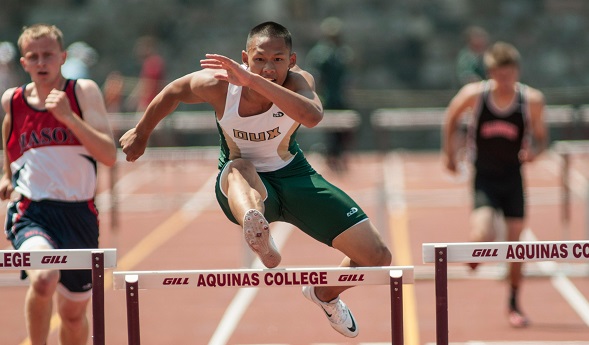
No Track, No Problem for Champion Dux
June 9, 2014
By Geoff Kimmerly
Second Half editor
Phil Hoover is looking forward to returning to Zeeland’s renovated stadium for the 2015 track and field season.
But his Zeeland West boys team – which shares the stadium each spring with neighboring Zeeland East and one of the district’s middle schools – might be hesitant to switch things up.
 It’s tough to question the methods that led the Dux to win their first MHSAA championship June 7 – despite having no track or field to practice on and no home meets during the regular season.
It’s tough to question the methods that led the Dux to win their first MHSAA championship June 7 – despite having no track or field to practice on and no home meets during the regular season.
In fact, West finished this season perfect, winning its league, Regional and the Lower Peninsula Division 2 Final and all 16 of its events this spring – despite traveling for every single one.
The track surface showed signs it needed replacing during last fall’s football season, but the football team was on its way to winning the MHSAA Division 3 championship. Demolition was put off until after football season ended, and reconstruction continued through last week.
“We as coaches agreed that we didn't want to make a big deal out of it,” Hoover said. “We went with the status quo. I don’t think they were stressed about it. The kids were great; they were never like, ‘Why don’t we have a track?’ They adapted quickly.”
And who needs a track when you've got a gym and hallways?
Coaches split with groups of athletes (the team had 65 total) to practice throughout the school – high jump in the gym, sprinters on the carpeted hallways, more events in other areas of the building.
Hoover, who has coached the team since the school opened in fall 2005, spent 3-4 hours every Sunday mapping where and what his athletes would practice over the following week.
Of course there were challenges. Tracks are curved and school hallways generally are not – so runners took off down a hall and had to make two 90-degree turns to run back.
And there had to be some break from tradition, like the usual Monday meeting spot at the track where the team would hash out its training schedule.
The Dux were able to use three lanes to the side of the track to work on hurdles and getting out of starting blocks, and also traveled to Hope College for a few practices.
There wasn't any kind of “us against the world” mentality Hoover could've conjured up as extra motivation for his team without a track. But he did say the all-road show might’ve benefited his athletes at the end of the season when they traveled for the spring’s most important meets.
It also surely helped to have a skilled and knowledgeable senior class that had been part of two MHSAA football championships and won the Michigan Interscholastic Track Coaches Association team state title in 2013 (the Dux ended up winning that event this spring as well). “We came into this year pretty focused to accomplish some things,” Hoover said. “We laid out the possibility of winning the state meet and focused on that.”
Zeeland West placed in seven events at the LP Division 2 Final at Houseman Stadium, with senior Jason Tran in the 300 hurdles its only individual champion. But the mix of points coming from sprints, hurdles and middle distance helped the Dux outpace runner-up Auburn Hills Avondale by 10.
Hoover said he missed this spring the daily scene at Zeeland’s staditum, where practices usually included 400 athletes mixing together from all three schools. But his Dux proved practice can make perfect – even if that practice comes in an unconventional setting.
“It’s strange here. The kids come to practice, and they really trust us,” Hoover said. “We feel we put out good training for them, and there’s not ever a question."
Good news for MHSAA hockey
A revised schedule coming this fall from the Michigan Amateur Hockey Association should provide a big boost to high school hockey in this state – and open up opportunities for athletes to play fall high school sports as well.
MAHA will this fall add an early season for its Midget A and AA teams – made up of high school-age players – allowing those players the opportunity to play both travel hockey in the fall and then high school hockey in the winter after that “early” travel season ends Nov. 8. MAHA also will play a "late" travel season – beginning Dec. 1 – which will allow travel hockey players the opportunity to play fall high school sports before hockey season in the winter.
Previously, the travel season began at the start of fall and concluded at the end of winter with MAHA’s state tournament. MAHA teams will still be able to play that traditional full season – but the MAHA state championship tournament in March will feature the top teams from the “early” and “late” seasons facing off after the MHSAA tournament is complete.
“The current system creates a lot of uncertainty and stress on the players who want to play high school hockey,” said Don Wright, MAHA high school hockey director, in a press release. “They have to gamble on which team they might make and hope they gamble correctly so they have a place to play come November. These expanded opportunities will also allow for increased skill development of these players prior to the start of the MHSAA season.”
The MAHA “late” season teams will hold tryouts after MHSAA hockey season practice has begun, allowing athletes who did not make their high school teams an opportunity to return to travel hockey for the winter.
Linked Up
Check out this Saginaw News story we came across leading up to the MHSAA Track and Field Finals on May 31.
Hugh Bernreuter tells of Saginaw Nouvel parent Celia Sullivan, who did not expect to see her son graduate as she suffered liver failure two years ago – but got that opportunity this spring thanks to another football mom, Sue Joynt, who donated 60 percent of her liver to Sullivan.
One of Sullivan’s thoughts that stuck most:
"I'm a bit of a control freak. I didn't need a transplant. I can go on. I thought I could beat it, but finally the doctors got through to me. This is something you don't beat. You cannot wait. You will die."
Click to read the entire piece.
PHOTO: Zeeland West's Jason Tran runs the 300 hurdles at this season's Lower Peninsula Division 2 Finals at Houseman Stadium.
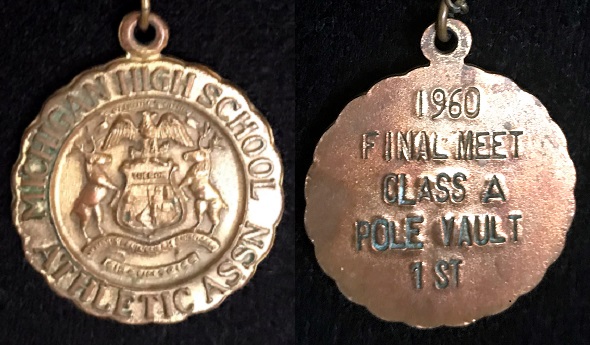
60 Years Later, Co-Champ Rediscovered
March 25, 2020
By Ron Pesch
Special for Second Half
Nicholas “Mickey” Turcheck tells a wild story. It involves a coin flip.
Involved in track & field for much of his life, Turcheck was a pole vaulter at Taylor Center during his high school days, then at Western Michigan University. He later served Taylor Center for more than three decades as track coach, where he mentored five state champions.
He also coached two future Olympians. Earl Jones, who won MHSAA Finals track titles in both 1980 and 1981, and grabbed bronze in the 800 meters at the 1984 Summer Olympics in Los Angeles. Another of his athletes, Deby LaPlante, qualified for the 1976 Summer Olympics in Montreal as a high hurdler.
In Turcheck’s possession is a medal. Etched on the back, pounded out in the style of the time, are five lines.
1960
FINAL MEET
CLASS A
POLE VAULT
1ST
Those 31 characters honor his MHSAA championship performance on what became a windy day in Ann Arbor at University of Michigan’s old Ferry Field.
But there is one problem. Turcheck’s name doesn’t appear on the MHSAA list of Finals champions. According to the list, the championship belongs to Joe Baldy of Monroe.
(The list has since been corrected and amended, per the story to be told below.)
Trackheads
For ‘trackheads’ – diehard fans of the sport and the events that comprise a track meet – as well as sports historians, a newspaper’s agate page is nirvana. Contained within the tiny type are the details that aren’t always relayed within the article covering a sporting event. Things like baseball batting averages, league standings, box scores, stat lines, team transactions, TV and radio schedules, and most everything else that doesn’t fix conveniently into the day’s sports section might appear on the page. For a track meet, a full agate listing will include place finishes as well as times, heights and distances that were used to determine winners of events, as well as detail on record performances that were equaled or topped.
Jim Moyes is a passionate sports fan. An undersized high school athlete at a small school, where participants of all shapes and sizes are valued, Moyes was the son of a prep coach at North Muskegon High School. He grew up and became, among other things, a beloved and respected broadcaster and public address announcer. Few were as well-prepared as Moyes, who studied agate pages, past performances, and, it seemed, the family trees of the participants prior to sitting before a microphone. His knowledge, as well as his sense of humor, was on display for 43 years in West Michigan, where he would balance his understanding and importance of an event with the awareness that, in the end, what we were experiencing was still just a game.
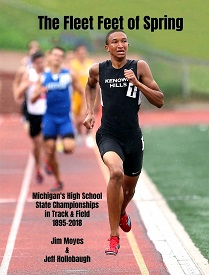 Well over 30 years ago he began his research into a passion project. Moyes is a ‘trackhead.’ And, because of this, in 2019, he officially became the author of a published book.
Well over 30 years ago he began his research into a passion project. Moyes is a ‘trackhead.’ And, because of this, in 2019, he officially became the author of a published book.
Way back, Moyes began digging into microfilm with the goal of capturing the names and events behind each MHSAA Finals track championship. He shared his initial research with the MHSAA, and for years the Association has highlighted his work on its website with lists of individual state champions on both their boys and girls track pages.
A couple of years before wrapping up his research, Moyes began work with another certified ‘trackhead,’ Jeff Hollobaugh – associated editor of Track & Field News, the voice of countless track meets, and as Moyes states, an “expert on this great sport” – to tell the stories of the meets in book form. “The Fleet Feet of Spring” – a history of Michigan’s High School State Championships covering the span 1895-2018 – was the result.
That’s 24,446 state champions. Simply put, its 439 pages contain a marvelous collection of statistics, stories and images.
But, with good reason, Turcheck’s name doesn’t appear in the publication.
Golden Age of Newspapers
Post-event press coverage on the 1960 MHSAA State Track Meet for most readers across Michigan arrived in their newspaper courtesy of coverage by wire-service reporters from The Associated Press or United Press International. With four meets to cover that encompass hundreds of prep athletes, the arch of the stories generally focus on record-setting events and streaks of success.
In Class A, the story was focused on the Pontiac Central squad that slipped past Flint Northern, 44-41, for its fifth title in six years. It was the seventh year in a row that the Vikings finished second at the meet. Pontiac junior Bredell Pritchett’s 59-foot-5¾ toss of the shot exceeded the previous state mark by better than two feet. Northern’s Maurice Pea, clocked at 9.8 seconds, tied a 35-year-old mark in the 100-yard dash. Al Ammerman of Dearborn established a new high jump record.
In 1960, the details of the pole vault simply weren’t the story.
Available space in newspapers is dictated by advertising. That certainly is the case today, and was most certainly the case back in the glory days of newsprint. Decisions are made by sports editors and staff on the amount of space available, and what agate will be printed. The results of a track meet, let alone the four simultaneous meets that comprise the MHSAA state championships, can certainly eat up plenty of real estate.
Relatively few papers around Michigan dedicated space to the MHSAA Track Championships back in May 1960. The old Detroit Times is among those that did include agate. Study of the listing however provides little clarity, as the paper listed only Metro Detroit finishers beyond the event winners. For the pole vault, that means confusion.
Pole Vault – “1 Joe Baldy, Monroe: Mickey Turcheck. Taylor Center: Bob Davis. Redford Union. and Larry Richardson. Livonia Bentley. were among those tieing for fourth. Distance 12 feet, 9 inches.”
The Grand Rapids Press agate adds haze to the mix. Baldy is listed in first, but Turcheck is listed as finishing second, followed by Flint Northern’s Jerry Wright in third. Davis, Richardson, Mike Pedler of Muskegon, J. Best from Battle Creek Central and Bill King of Traverse City are listed as occupying fourth place
The Battle Creek Enquirer lists only Baldy as the winner of the event and John Best “tied for fourth.” The Lansing State Journal agate shows only Baldy as the event winner. No track agate appears in the Detroit Free Press. Although the paper notes that team-wise, Birmingham finished third with 18 points, followed by Dearborn, Ann Arbor, Muskegon and Saginaw Arthur Hill in its coverage, the results from the Class A pole vault are not mentioned.
The Traverse City Record-Eagle does not include agate, but the article notes King’s fourth place finish, and that the Trojans track team spent the night sleeping on tumbling mats in the Saginaw Arthur Hill gymnasium when its bus broke down on the return trip home from Ann Arbor.
So, with little surprise, Moyes’ research concluded Baldy was the 1960 Class A pole vault champion.
Story of the Medal
In early March, Tony Mifsud, a longtime track coach at Dearborn Divine Child, contacted MHSAA Director of Broadcast Properties John Johnson about the story.
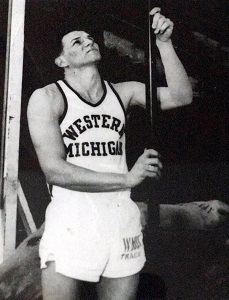
Turcheck was recently visiting a friend, Bob Parks, the head track coach at Eastern Michigan University for 34 years and an assistant track coach at Western Michigan during Turcheck’s time in Kalamazoo competing for the Broncos. On a visit this past fall, Parks mentioned the Moyes and Hollobaugh book that he had recently received.
“Mick, your name is not listed there,” said Parks. “I know you were tied for the state championship because I was the coach at Redford Thurston at that time and I was at the state meet. I remember you being announced as the co-state champion of the pole vault.”
“I said, ‘Really?’” recalled Turcheck from his home in Taylor.
After the visit, he made a couple of phone calls to friends. In turn, some of those folks began reaching out to others with the story.
According to Turcheck, after the pole vault was over, a meet official said they only had one medal and they were going to flip to determine who would receive it. Turcheck won the coin flip and was awarded the souvenir. A duplicate medal was to be mailed to his co-champion.
Newsprint and the Miracle of Microfilm
Before the days of smartphones, e-mail, websites, pop-up ads, and cloud storage, the history of cities, big and small, was captured in print and sold on street corners, at newsstands, and, beginning in 1947, by coin-operated vending machines.
Monthly subscriptions meant home delivery of the day’s news, and newspapers were everywhere.
Before Craigslist and Google Ads, there was money to be made in helping businesses advertise their wares, employers to advertise job openings, and for individuals to sell items and offer apartments for rent in the classifieds. That strong revenue stream supported large staffs and solid coverage of local events at daily and weekly newspapers.
Some of that content – that history – is slowly coming online, but most of it remains tucked away on microfilm and microfiche in local libraries across America.
And sometimes, local pride resulted in details about the exploits and accomplishments of area athletes to appear in smaller town publications that cannot be found elsewhere.
Niles Kruger, a sportswriter at the Monroe Evening News, followed up on a request by Johnson to check microfilm from newspapers in the area for any detail that might exist. Fortunately, the coverage in the Evening News appears to help clear up much of the story.
The article also illustrates an issue often injected upon microfilm by small agate-style typeface. Characters can often bleed or blur and appear to be other letters. A lower case ‘s’ can look like an ‘a’ or an ‘e’; a lower case ‘i’ can look like lower case ‘l.’ Unexpectedly, this, too, was illustrated here.
And sometimes, long lists are subject to other errors.
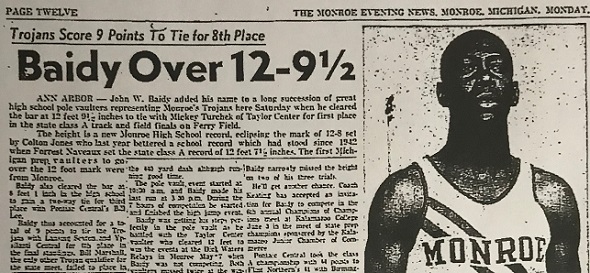
‘Baidy’ not ‘Baldy, ‘John’, not ‘Joe’
“ANN ARBOR - John W. Baidy added his name to a long succession of great high school pole vaulters representing Monroe’s Trojans here Saturday,” stated the Evening News, “when he cleared the bar at 12 feet 9 ½ inches to tie with Mickey Turcheck of Taylor Center for first place in the state Class A track and field finals on Ferry Field …”
“Baidy also cleared the bar at 6 feet 1 inch in the high (jump) to gain a two-way tie for third place with Pontiac Central’s Bill Lee. Baidy thus accounted for a total of 9 points to tie the Trojans with Lansing Sexton and Ypsilanti Central for 8th place in the final standings.”
While there is no mention of the flip for the metal, the article backs up Turcheck’s recall of the day.
Recognizing that despite their best efforts, Moyes and Hollobaugh know that errors can appear in the publication. In their “Notes to the reader” section, they ask readers to please make contact if any mistakes are spotted.
“Thanks to today's modern technology Jeff Hollobaugh will be able to make the appropriate corrections in our book” noted Moyes from Florida via email, noting the marvels of the times we live in. “Better yet for Jeff & I,” added Moyes, displaying his comedic style, “with the amended corrections maybe Mickey Turcheck will purchase our newly revised book.”
Search for Baidy
“They wanted to flip a coin,” said Baidy recently, surprised in the sudden interest in a day from so many years ago and chuckling at the memory. “He got the call and got the medal. I really don’t remember if they told me if I was supposed to get a medal (in the mail). Right after that I had to go to the high jump or something.”
Baidy – who also tied for the Class A Finals high jump championship in 1959 – had received a call earlier on this day from his long-ago opponent from Taylor Center.
“I would certainly like to meet him again,” said Turcheck. His former high school sweetheart and bride had used her smartphone to seek out Baidy’s contact information, and soon after, the two old athletes were reminiscing about the day. Turcheck pitched the idea of getting together for lunch or dinner sometime soon.
“That’s what he wants to do, and it’s all right with me,” Baidy said, noting plans after things settle down. “We’re lucky to still be alive.”
 Ron Pesch has taken an active role in researching the history of MHSAA events since 1985 and began writing for MHSAA Finals programs in 1986, adding additional features and "flashbacks" in 1992. He inherited the title of MHSAA historian from the late Dick Kishpaugh following the 1993-94 school year, and resides in Muskegon. Contact him at [email protected]:void(0);t with ideas for historical articles.
Ron Pesch has taken an active role in researching the history of MHSAA events since 1985 and began writing for MHSAA Finals programs in 1986, adding additional features and "flashbacks" in 1992. He inherited the title of MHSAA historian from the late Dick Kishpaugh following the 1993-94 school year, and resides in Muskegon. Contact him at [email protected]:void(0);t with ideas for historical articles.
PHOTOS: (Top) The 1960 Finals championship medal, front and back, awarded to Baidy. (2) The Fleet Feet of Spring has been revised based on the latest re-discovery of a co-championship. (3) Mickey Turchek went on to compete at Western Michigan. (4) The Monroe Evening News announced John Baidy’s championship pole vault as part of its coverage of the 1960 Class A Track & Field Finals. (Turchek photo courtesy of the Turcheck famly; newspaper clipping courtesy of the Monroe Evening News.)

